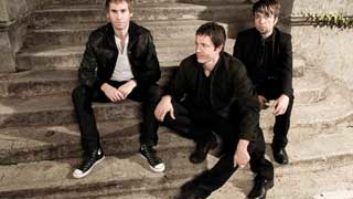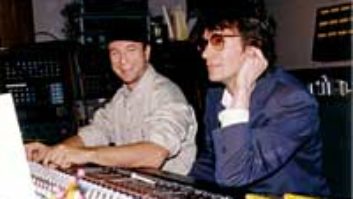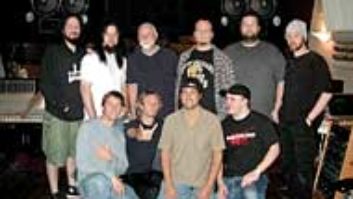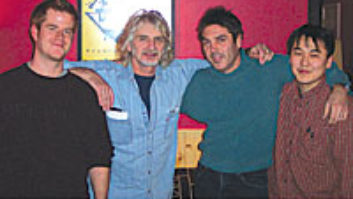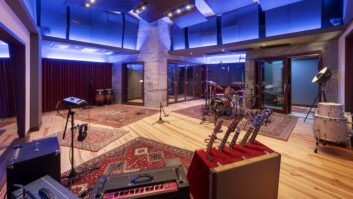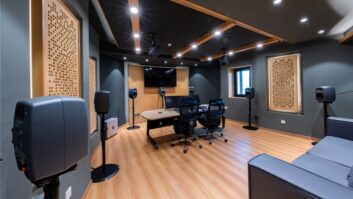Third Eye Blind lead singer Stephan Jenkins is not an ordinary guy, and as such, he’s grown weary of ordinary recording studios. When it came time to work on their latest album, Crystal Baller, Jenkins, his band and their longtime engineer/producer Jason Carmer felt that the mood was right to strike out on their own. Enlisting the guidance of studio designer Chris Pelonis, the band capitalized on a commercial-space surplus and set up shop in San Francisco’s media-friendly SOMA (South of Market) district. Nestled between the vacant confines of once-bustling Internet start-ups and the historic cafes and boutiques of South Beach, the band’s new home, Morningwood Studios, mirrors its surroundings by mixing cutting-edge technology with a healthy dose of classic character and charm.
“In most recording studios, you can smell the dread on the wall,” says Jenkins. “You can feel the clock. You feel the balding, late-40s, coke-addicted studio owner walking in on your session to impress his friends. [We wanted] to create an environment that really speaks to those kinds of issues. Also, Jason and I have a very particular and methodic concept about sound. We like some period in the early to mid-’70s when Rupert Neve’s ears were at their peak. This is a housing project for those little toys.”
“During the course of the last record, we started to say, ‘Wouldn’t it be nice if we had our own studio?’” adds Carmer. “We were giving all of these other people so much money. Then we started talking about this record, and we were doing pre-production at this studio called Tiny Telephone in San Francisco, and still talking about building a studio. One day, Stephan was riding his motorcycle around and saw [a sign that read] ‘recording studio for lease.’ He had actually recorded in this studio the day of the [’89] quake. And we came and checked it out and leased it last year.”
After talking to a number of studio designers, the band brought Pelonis in to help rework the space. Jenkins and Carmer were both proponents of his designs, having worked in various Pelonis-built mastering suites and recording studios. The main worry that Jenkins and Carmer wanted addressed had to do with the overall accuracy of the control room. After years of working in large multimillion-dollar studios, the band simply wanted an uncolored listening environment.
“They had a shell to start with,” explains Pelonis. “We designed a control room specific to the band’s requirements: accuracy and musicality without compromise. The reverb time is plus or minus 15 to 20 milliseconds from 20 to 20k Hz. The room is really punchy, accurate and very revealing. The bottom end is very present and tight without being exaggerated. The reports I’ve gotten is that they’re happier with their own control room than anything they’ve ever worked in.”
“We wanted to have a really accurate control room, and we do,” Jenkins explains. “It’s physics. Our control room is excellent. If you make a sound in there and listen through those speakers and then take it somewhere else, you will never be surprised.
“The control rooms [that Chris builds] are really even-sounding. A lot of control rooms, especially in bigger studios, seem to have a sheen or a glossy sound. And that just makes me nervous. I don’t want to hear the room. I just want to have a nice flat room that really has accurate low end. One thing about Chris’ designs is that the low end is very tight and very even across the whole room.”
The space includes the main control room, a live room with a small iso booth, a secondary Pro Tools editing suite, a lounge, and a number of isolated tape rooms and storage spaces. “In the live room, we didn’t really change that much,” Carmer adds. “We put up some different surfaces and got some bass traps and diffusers.”
Outfitting the studio wasn’t terribly difficult for the band because they had already amassed an excellent collection of gear that they used to lug from studio to studio. “When we go into another recording studio, we bring all of our own shit,” Jenkins adds. “We don’t actually use their room. We monitor off their board, but we use all of our own mic pre’s, compressors and mics.”
The main console is a Sony DMX-R100 that interfaces through Apogee AD-8000 and PSX-100 converters with a full-blown Mac-based Pro Tools|HD system. However, the real stars are a refurbished Helios board and a hot-rodded Ampex MM1200 outfitted with an 11-track head stack. The basic premise is simple: Everything is recorded through the Helios board or pre’s onto the Ampex and then flown into Pro Tools for editing. All of the monitoring is done though the Pelonis Signature Series Mains (which are the first professional mains to boast a frequency response of 21 to 45k Hz) and a set of Yamaha NS-10s. In addition to the vintage Helios board, pre’s and some Neve 1081/1073 modules, Carmer also uses some more-modern preamps and outboard processors including selections from Sony, Focusrite and Universal Audio.
“[The word] ‘hybrid’ always sounds like somebody’s car or something like that,” Jenkins states. “Anything that’s lime-green is a hybrid. But [here], it’s a very simple concept. Classic analog gear creates the sound we covet. It’s the sound of Bob Marley and Led Zeppelin and sort of the classics of recording. And modern technology and digital-information management improves the sound by allowing you all kinds of ways of manipulating it that analog doesn’t [allow]. So the philosophy of the studio is to get pristine, classic analog signal path and be able to manipulate it in the most up-to-date fashion. That’s what it’s about.”
Following the completion of their new record, Morningwood Studios will actually transition from a project studio into a commercial facility. And, rather than cater to strictly high-end users, Jenkins and Carmer are hoping to attract younger up-start musicians who might find the facility’s affordability and “hands-off” attitude a plus.
“I think that we have put a lot of thought into this place that is going to make sense to people,” Jenkins concludes. “And that is what we’ve really wanted in a studio — a home-like environment and no one bothering you, and a focus on tone and flexibility and ways of manipulation. And most studios you go to don’t have that as their concept.”
MORNINGWOOD STUDIOS SELECTED GEAR LIST
Sony DMX-R100
Helios console
Ampex MM1200
Digidesign Pro Tools | HD
Neve 1081/1073
Pelonis Signature Series Mains
Yamaha NS-10s
Sony DRE-S777
Apogee PSX-100
Apogee AD-8000
TC Finalizer
Tascam DA-20
Panasonic SV-3800
Focusrite Red 3
Eventide Ultra Harmonizer
Eventide DSP 4000
Empirical Labs Distressor
Empirical Labs Fatso
TC FireworX
Tech 21 SansAmp
Universal Audio 1176
Universal Audio LA-2A
Pultec EQ
Lang Electronics EQ
Little Labs PCP
Mics
Telefunken Elam 251
Neumann U67
Neumann U87
Electro-Voice 66
Electro-Voice RE-20
Shure SM57s
AKG 451/414
Related Articles
Steinberg Announces Beta Testing For Nuendo for Mac OS X
Mar 25, 2002 12:00 PM, Editors
Steinberg has announced that it has reached the beta-testing phase for Nuendo Mac for OS X, and is preparing to start a public beta program for registered…
…
